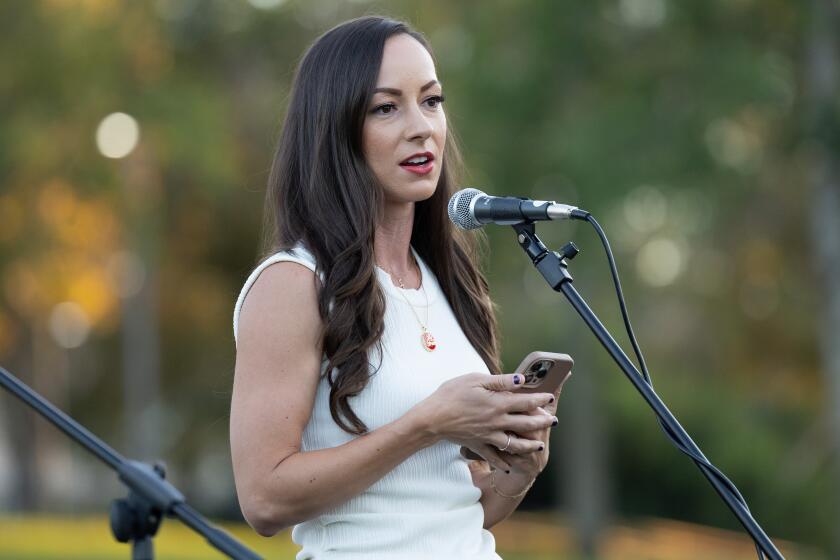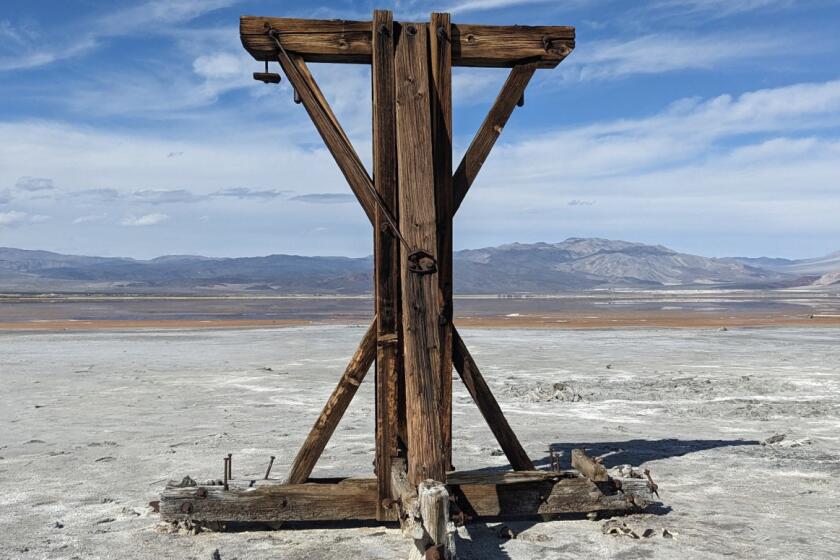Lawyers Guilty of Trying Surrogate Case in Media : Justice: Attorneys in the Anna L. Johnson case have drawn the press into the battle to an extreme degree.
It was once a golden rule for lawyers: Don’t try your case in the press.
But that already tarnished code has been blackened further by attorneys on both sides of the Anna L. Johnson surrogate mother case. Indeed the media--often accused of exploiting courtroom drama to sell newspapers or boost ratings--have been drawn intimately and uncomfortably into this legal battle.
Lawyers contacted the press even before the first court document was filed by Johnson, who seeks to keep the baby she was hired to bear for his genetic parents, Mark and Crispina Calvert. Attorneys have given dueling interviews to waiting TV cameras almost daily--while each side accuses the other of publicity-mongering. One lawyer accompanied Johnson onto The Donahue Show.
Inside the courtroom, Johnson has been grilled about what she told Phil Donahue and what happened to the money she was paid to appear on the show. Judge Richard N. Parslow Jr. has chided the lawyers for grandstanding, and has asked his wife and clerk to monitor the media coverage.
Last week, the Calverts’ lawyers forced the Los Angeles Times reporter covering the case to testify--and Johnson’s attorneys then sought to bar the reporter from the courtroom on the grounds that she was a witness.
Several legal experts interviewed last week suggested that when the judge issues his decision Monday, only the lawyers will win.
“Big law firms pay handsome fees to marketing and media consultants to go out and tell them how to get their name in the limelight,” one attorney said. “Name recognition! It could be beneficial down the road.”
Lawyers and judges in other highly publicized court cases declined to comment publicly on the media habits of their brethren in the Johnson case. “Oh God, I don’t want to be sued,” said one prominent Los Angeles attorney, who then begged not to be quoted by name.
“Whether you win the big case or lose the big case, what people remember is that you were big enough to be in the big case,” said another legal veteran, whose own career skyrocketed even though he lost a star-studded trial.
“It’s the old Hollywood line: Say anything you want about me, as long as you spell my name right,” he added.
Advocates for the baby boy, however, aren’t so sure. They fear the exposure may traumatize the month-old child, whom Johnson calls Matthew and the Calverts call Christopher Michael.
“The child’s right to privacy has been compromised by this three-ring circus,” said William G. Steiner, the guardian appointed by the court to represent the baby, on the day that three dozen reporters, photographers and producers showed up in Orange County Superior Court to find out which “parents” would be allowed to take the baby home from the hospital.
“When you have lawyers more interested in publicity than in this child, it’s absolutely unforgivable,” said the baby’s attorney, Harold LaFlamme. “The one thing that surprises me right now is that they haven’t sold tickets.”
Fearing such exploitation, Judge Parslow ordered the parties not to release photographs of the child or take him places where he could be photographed. The order did not bar the media from scrambling to get a picture if they could, however. And the media did just that, with a mob of photographers surrounding the infant as he was carried from the hospital. The Times also ran on Page 1 an exclusive picture of the newborn bundle arriving at the Calverts’ home, further inflaming the coverage war.
Attorneys for The Orange County Register and The Times objected to the judge’s order limiting access to the baby. They argued that the beleaguered Calverts might be forced to put blankets over their windows, creating an “unnatural situation.”
“What might possibly be unnatural is not leaving people alone in certain situations,” Parslow retorted. “Maybe people could back off just a little bit.”
The judge ultimately allowed a single photographer to take the baby’s picture and distribute it to other media, and the newborn bundle was duly splashed across television screens and newspapers, including The Times, which ran the image on Page B1 of the Orange County edition.
Johnson’s case is considered precedent-setting because she is the first surrogate mother to seek parental rights to a baby to whom she is not genetically linked.
The boy was conceived in a petri dish from the Calverts’ egg and sperm, then implanted in Johnson’s womb. Mark Calvert testified that Johnson had promised to be an “incubator” for $10,000. But Johnson, backed by “Baby M” surrogate mother Mary Beth Whitehead-Gould and other opponents of surrogacy contracts, said she grew attached to the baby as she carried him.
Lawyers for both sides maintain that the media--and hence the public--should be informed about the psychological, ethical and legal questions raised by this new biotechnological feat.
“We need to know everything we can about it so we can stop it,” said Johnson’s attorney, Richard C. Gilbert of Gilbert & Marlowe in Santa Ana.
“We would have much preferred to have privacy and anonymity,” said the Calverts’ attorney, Christian R. Van Deusen, of Van Deusen Youmans & Walmsley of Santa Ana. “One of the reasons my clients felt that they had to speak out was because of the outrageous accusations made against them. . . . If you don’t say ‘Wait a minute, that’s not true,’ it amounts to a tacit admission, so you have to speak out.”
In interviews Friday, Gilbert said he and his client have been misquoted and had their remarks distorted by the press. But both he and Johnson stand by their decision to take their case to the national media.
“The media have been very helpful to me,” Johnson testified last week. “If it wasn’t for them, I wouldn’t have gotten world-renowned witnesses” to testify on her behalf.
Gilbert said Johnson had turned to the media in desperation, hoping that at least the publicity would allow the child to track her down later if he so desired.
“We had a mother who was going to lose her child and have her child taken away from her forever. . . ,” Gilbert said. “So she laid bread crumbs in the park so that the baby could eventually find his way back to his mother, Anna Johnson. And those bread crumbs are now laid coast to coast, continent to continent and around the world.”
Attorneys for the Calverts, however, have attempted to imply that Johnson’s willingness to use the media to publicize her case demonstrates that she is an unfit mother. They subpoenaed Johnson’s former roommate, who testified that Johnson’s quest to keep the baby was motivated by a desire for money and publicity.
Both Gilbert and Van Deusen said their careers are sufficiently established not to require further promotion.
Meanwhile, the media itself did little introspection about its role in the case until Times reporter Catherine Gewertz was forced to testify about damaging statements published after an August interview with Johnson. Gewertz had quoted Johnson as saying that she was not bonded to the baby, and Johnson later denied having made the remark.
The Calverts’ lawyers called Gewertz to the witness stand, and the reporter confirmed the remark. Gilbert tried unsuccessfully to have Gewertz barred from the courtroom since she was a witness in the case.
Gilbert said Friday that the Times should have assigned another reporter to the case as soon as Gewertz was subpoenaed.
“I think it’s not appropriate,” said Gilbert. “How can Gewertz or any journalist continue to maintain their objectivity when they know that they are going to be testifying and their credibility will be challenged?”
“That sounds to me from afar like a lawyer grandstanding,” said Tom Goldstein, dean of UC Berkeley’s Graduate School of Journalism. “If what (Gilbert) said was the case, then you could basically shut down courtrooms to reporters by having them subpoenaed.”
Other attorneys called for comment on media coverage of the case, however, said the real problem with media coverage of “big” court cases such as Johnson’s is the tendency of reporters to rely on material gathered on the courthouse steps instead of inside the courtroom.
This practice is especially common in television, and in cases when reporters or cameras are barred from the courtroom. But sources said the practice allows and even encourages lawyers to try their cases on national television.
“When somebody goes out on the courthouse steps, what they’re giving you is not a fact, it’s their own opinion . . . and you guys should really be reporting the facts,” said Robert J. Perry, who prosecuted former auto maker John Z. DeLorean on cocaine charges and is now a partner at Epstein Becker Mulkeen & Green in Los Angeles.
“The reason the media is easily manipulated is it’s faster and easier to have someone else--particularly a participant--to summarize the events for you. And that is the blurring of fact and opinion that perverts the content of the reporting.”
If legal maneuvering is so complex that reporters do need help in interpreting events, Perry said, they would do better to get a “quickie opinion” from an objective third party than from the attorneys trying the case.
The DeLorean case was considered a milestone in media coverage of trials because DeLorean’s defense attorney, Howard L. Weitzman, gave press conferences on the courthouse steps while prosecutors refrained from comment. DeLorean was acquitted, and Perry now says the prosecution eered in believing the jury would not be influenced by the publicity--though the government might have lost anyway.
Weitzman was known and respected in Los Angeles before the DeLorean case, but now he’s “a household word” in legal circles, according to a prominent judge.
In a brief telephone interview, Weitzman, a partner at Wyman Bautzer Kuchel & Silbert in Los Angeles, said he believes there is nothing wrong with a lawyer trying to correct public misperceptions about his client.
“I do think it’s inappropriate to get personal with the other side, and I do think it’s inappropriate to try one’s case in the media,” Weitzman said, defining the latter as presenting facts to the press before they are introduced in court.
“What I have real trouble with is creating the media interest,” said Weitzman, who said he would not send out a press release about a case before it is filed. Weitzman said the media were drawn to the DeLorean case because the auto maker was already a celebrity. “The lawyer should not be generating the publicity, the lawyer should be responding to the media’s and the public’s need” for information.
When lawyers do take their case to the press, it is usually to counter damage done by police, prosecutors or the other side, or to prevent their clients from winning the court case but losing in the court of public opinion. Sometimes it is a veiled attempt to influence a jury.
In the Johnson case, the ultimate audience isn’t listening. Judge Parslow, who will decide without a jury whether Johnson has parental rights, has tuned out news reports to avoid being influenced, according to his clerk, Marci Dambert.
Dambert is assigned to monitor the coverage to make sure that what is said inside the judge’s chambers is not misrepresented to the press in the courthouse hall. She jokes that she’s getting scheduling tips from the papers.
“The lawyers have had a tendency to notify the press before they notified us on what their next move was,” Dambert said. “We were the last to know.”
To some, the relaxation of rules against lawyer advertising makes the old notion that it is unseemly for a lawyer to give interviews seem almost quaint.
In 1962, for example, Life magazine sent a reporter to profile an up-and-coming New York law firm, trailing its young partners and charting the bar’s mysteries. The firm did not solicit the piece but agreed to cooperate, and the results were “flattering,” said Harry F. Weyher, of Olwine, Connelly, Chase, O’Donnell & Weyher in New York.
But the article caused “an uproar” at the New York Bar Assn., and in 1963 the firm was censured, Weyher said. Today, the law is much more commercial, he said.
“I think it’s very undignified, and it really does not help the correct resolution of disputes,” Weyher said.
More to Read
Start your day right
Sign up for Essential California for news, features and recommendations from the L.A. Times and beyond in your inbox six days a week.
You may occasionally receive promotional content from the Los Angeles Times.






